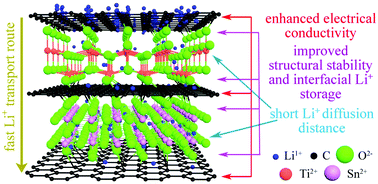Nanoscopically and uniformly distributed SnO2@TiO2/C composite with highly mesoporous structure and bichemical bonds for enhanced lithium ion storage performances†
Abstract
The ultralow volume deformation (<4%) and low cost have aroused great interest in using TiO2 as the anode of lithium ion batteries (LIBs), but its low capacity (168 mA h g−1), no more than half of the theoretical capacity, limits its practical application in high-energy-density LIBs. In order to solve this problem, here we propose a one-step method for fabrication of the SnO2@TiO2/C nanocomposite, which features a superior nanoarchitecture with mesopores, interfacial chemical bonds, vast phase boundaries, carbon coating, and ultrasmall nanocrystals. These nanostructures endow SnO2@TiO2/C with a high capacity of 830.7 mA h g−1 at 0.5C after 100 cycles, excellent cyclability over 1000 cycles with negligible capacity loss per cycle (0.004%) at 10C, and a high lithium ion transport rate within a few seconds for one cycle. Importantly, the full cell with prelithiated SnO2@TiO2/C as the anode and commercial LiCoO2 as the cathode achieves a high energy density of 328.4 W h kg−1 at 0.1C and 245.9 W h kg−1 at 1C, which are superior to those of previously reported TiO2-based materials.

- This article is part of the themed collection: Advances in Energy Materials


 Please wait while we load your content...
Please wait while we load your content...